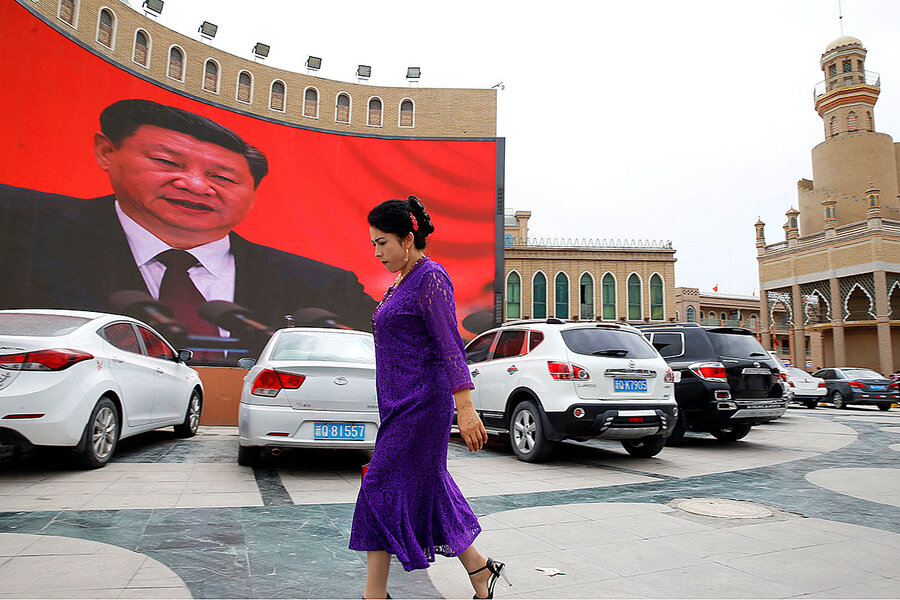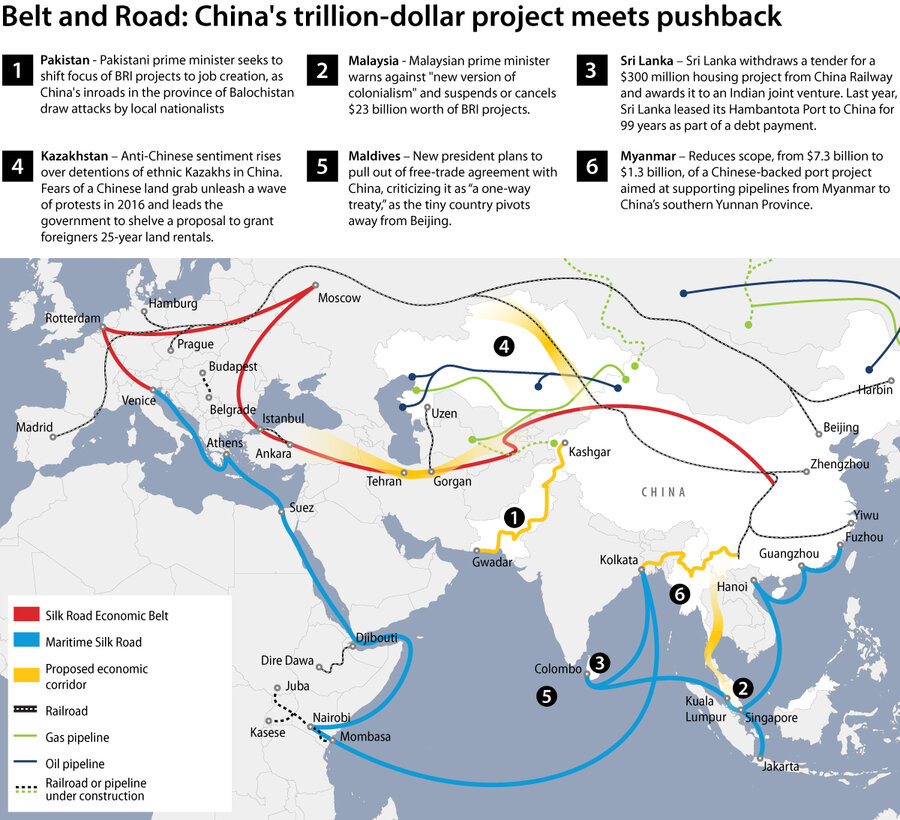Connection or control? On the new Silk Road, two tales of China compete
Loading...
| Kashgar, Xinjiang, China
The Pakistani businessman braved the rugged Karakoram Highway, crossed the freezing Khunjerab Pass, and spent an hour undergoing security at China’s border to reach the city of Kashgar, in the frontier region of Xinjiang.
Eager to promote his adventure tourism company, the young entrepreneur set out in October in hopes of finding a travel agency to partner with. Instead, he ran up against China’s paramilitary surveillance state and its anti-Muslim policies.
It began with a simple transaction – trading US dollars for Chinese yuan. He passed through one of Kashgar’s ubiquitous airport-style security checks, entered a Bank of China branch, and waited to see a teller. “I went to the window at my turn, but when they saw my first name was Mohammad, they refused to change the money,” he says, asking that his last name be withheld.
Why We Wrote This
Beijing has cast itself as a global leader, trumpeting connectivity and trade. But its policies at home underscore a different reality, and more of China’s partners are taking note.
Mohammad soon learned that, as a Muslim and foreigner, he would be met with intense suspicion and harassment by authorities in Xinjiang. He was forbidden from praying at Kashgar’s ancient Id Kah mosque, told that the posted prayer times were just for show. Hotels denied him rooms. Police interrogated him, and he spent a night in a squad car. Soon, he abandoned his plan.
Xinjiang authorities have detained as many as 1 million people in reeducation camps, according to human rights groups, in a campaign to eradicate what authorities label the “three evil forces” of separatism, religious extremism, and terrorism.
Most are Muslim ethnic minorities, many targeted because of contacts or travel in 26 “sensitive countries” with large Muslim populations, including Pakistan. Some are spouses and children of citizens from neighboring Pakistan, Kazakhstan, and elsewhere, and foreigners have been detained. The repression is complicating foreign ventures like Mohammad’s – and also Beijing’s largest overseas experiment of all.
China has pledged $1 trillion in loans and investments to its Belt and Road Initiative (BRI), a plan to build a vast web of roads, railways, ports, and pipelines across nearly 70 countries on three continents, tracing the ancient paths of the Silk Road. The goal is to spur commerce and interconnectivity, while advancing Chinese strategic interests and influence, analysts say.
Xinjiang, a huge, resource-rich swath of desert and mountains on China’s western periphery that shares borders with six countries, is an essential BRI hub and gateway to the rest of Eurasia. But experts warn that the harsh crackdown here, which Chinese officials argue is needed for stability, exposes a basic contradiction – and weakness – underlying China’s push to assert itself as a world power.
“The fundamental contradiction at the heart of the strategy … is between the idea of connectivity and the flow of Chinese goods, ideas, and information globally, and this concern for stability domestically,” says James Leibold, an expert in Chinese ethnic policy at La Trobe University in Melbourne, Australia. “You can’t have true connectivity and leadership on global trade when domestically your key driver is stability maintenance and locking down people.”
President Xi Jinping has centralized the Communist Party’s power – with himself at the helm – to a degree not seen since the rule of revolutionary leader Mao Zedong. Meanwhile, he is tightening the party’s grip on not only Xinjiang but many aspects of Chinese society, highlighting Beijing’s authoritarian priorities in a way that experts say limits the appeal of a global leadership role.
“It speaks to an inherent weakness in China itself, the necessity to repress people to this extent,” says Elizabeth Economy, senior fellow and director for Asia studies at the Council on Foreign Relations in New York. China’s autocratic trend, along with pressing internal problems such as economic inequality, pollution, and the weak rule of law, undermine Beijing’s efforts to advance its “soft power” and promote itself as a model for other countries to follow, she says.
“With artificial intelligence, the installing of cameras, what is going on at universities, constraints on the internet – it’s part of a continuum of political repression and a fusion of political and technological means of repression,” Dr. Economy says. “There are few citizenries globally that will look at that as an attractive option. That is a big challenge for China as it goes forward globally and tries to sell itself.”
Belt-er beware
Since the Communist Party took power in 1949, China has mobilized a large migration into Xinjiang of millions of ethnic Han Chinese, who now make up nearly 40 percent of the population once dominated by Muslim, Turkic-speaking ethnic groups such as Uyghurs and Kazakhs. Hans have taken over land, commerce, and oil and gas industries as well as other resources, and typically hold higher paying jobs. This encroachment – as well as the party’s severe restrictions on Islam and minority cultures – has caused resentment among Uyghurs and other Xinjiang ethnic groups.
Similar concerns exist in some countries involved in BRI, with local people worried Chinese workers and companies will gain the lion’s share of jobs, sales, profits, and other economic gains. China’s polluting plants, relatively lax safety standards, and use of what critics call “debtbook diplomacy” to extract concessions when countries fail to repay Chinese loans have also stirred public opposition, as well as doubts in some governments that initially welcomed the influx of Chinese-funded projects.
A flagship BRI project in Pakistan, the $62 billion China-Pakistan Economic Corridor, includes a 2,000-mile conduit of roads, railways, and pipelines linking Pakistan’s Chinese-operated port of Gwadar with Xinjiang. The pipelines will create the fastest route for China to import oil and gas from the Middle East and Africa.
Key infrastructure will go through the region of Balochistan, where nationalists charge that local people will benefit little from the project. Popular opposition is significant, and Pakistan’s new premier Imran Khan has reportedly pushed to focus the project on job creation. In late November, a militant nationalist group that opposes the project, the Balochistan Liberation Army, attacked the Chinese consulate in Karachi.
Kazakhstan, where China has invested heavily in the energy sector, is another key BRI partner where concerns over Chinese influence are growing. Beijing is also building a major rail hub in Kazakhstan to load and unload trains running from China toward Russia and western Europe. But in 2016, when Kazakhstan’s government proposed allowing foreigners to rent land for 25 years, protests erupted in opposition to what many Kazakhs feared would turn into a Chinese land grab, and the government postponed the plan. This year, Kazakhstan has quietly pressed China to release Kazakh citizens from detention in Xinjiang, as more ethnic Kazakhs speak out about about how they or their relatives have been ensnared in the camps.
In Malaysia, amid concern over what Prime Minister Mahathir Mohamad calls “a new version of colonialism,” the government this year suspended a $20 billion BRI railroad project and canceled pipeline projects worth $3 billion backed by China. Mr. Mahathir has vowed to review all “unequal treaties” linked to Beijing.
And in southern Sri Lanka last year, China obtained a 99-year lease on a port after the city of Colombo failed to repay Chinese loans, a move criticized as an erosion of Sri Lankan sovereignty.
“We have seen a lot of backlash and projects stalled,” says Economy. “The talk about the major land acquisitions in Kazakhstan and the port in Sri Lanka has bred calls of neocolonialism.” Problems with China’s overseas business practices – such as debt sustainability, environmental concerns, and labor issues – are not new, but now the scale is magnified, analysts say.
Exporting ideas
The gap between China’s rhetoric of interconnected development and the reality of its policies on the ground is felt acutely on the streets of Kashgar. Wall paintings of smiling and dancing ethnic minorities and huge red banners proclaiming love for the Communist Party contrast with the fearful looks on the faces of people walking by. Helmeted police carrying rifles and shields scan people’s IDs and cellphones at checkpoints before they can enter neighborhoods ringed with barbed wire and surveillance cameras. Police lead shopkeepers armed with clubs in mandatory anti-terrorism drills at set times each day.
“The Chinese state needs to be in complete control [in Xinjiang] and so they just keep hammering the nail harder,” says Sean Roberts, director of the international development studies program at George Washington University’s Elliott School of International Affairs. Dr. Roberts believes the government views the Uyghur population in Xinjiang as an obstacle to Beijing’s economic expansion plans, and so is pressing ahead with strong-armed cultural and ideological assimilation.
Chinese officials and experts defend the stringent security and reeducation camps – which they call “vocational training” facilities – as needed to prevent terrorism.
“The three evil forces – separatism, extremism, and terrorism – are stubborn diseases,” wrote Niu Changzhen, an official at the general office of Xinjiang’s Communist Party Committee, in an October article in the state-run Global Times newspaper. “Acute illnesses need equally drastic medicine.”
Since the 1990s, Uyghurs have committed a number of knife and bombing attacks, and some protests in Xinjiang have turned violent. But many foreign analysts who study the region say China has exaggerated the terrorist threat, inaccurately labeling Uyghur rights groups and a small number of militants as terrorists. They attribute spontaneous acts of violent resistance by ethnic Muslims to China’s decades of repression. “The Chinese government has created the only enemy it ever faced from Uyghurs,” Roberts says.
As part of China’s bid for greater influence, Beijing is promoting counterterrorism cooperation with Central Asian nations and others participating in BRI, while seeking to export its values, policies, security systems, and surveillance technology. This is a lucrative prospect for Chinese companies profiting in Xinjiang, and for China’s race to lead the world in artificial intelligence. A representative of the Chinese security software firm Leon Technology, which is heavily involved in Xinjiang’s surveillance state, said at a 2017 conference that the market has “huge and unlimited potential” and Leon seeks to become the most influential security firm in Central Asia, according to a transcript of his speech by the ChinAI newsletter, which focuses on China’s artificial intelligence policy and strategy.
“To crack down on the ‘three forces,’ international cooperation is of prime significance, especially coordination among countries in South and West Asia and Central Asia, which serve as the main gateways for infiltration and escape of Chinese terrorists,” wrote Wang Peng, an associate research fellow at People’s University in Beijing, in an August op-ed in Global Times.
Chinese officials suggest other countries should emulate the anti-extremist policies and approach to human rights in Xinjiang. China’s model emphasizes state-led development to provide for the basic needs of the majority, often at the expense of political, civil, and minority rights. The severe restrictions in Xinjiang are “ensuring most people’s safety, which is protecting human rights to the greatest extent,” said Li Wei, a Beijing-based terrorism expert, in a Nov. 20 Global Times article.
Eyes on Xinjiang
Yet China’s aspirations as a global power may suffer as the world takes note of its actions in Xinjiang.
More than 630 scholars from 40 countries, 21 of which participate in the BRI, have signed a statement urging action to address “the mass human rights abuses” in Xinjiang. The Nov. 26 statement calls for economic sanctions on Chinese leaders and companies involved with the detentions, UN action to investigate and close the camps, and expediting asylum requests for members of Xinjiang’s Turkic Muslim minority groups. It urges countries negotiating BRI projects to make their participation contingent upon China ceasing repression in Xinjiang.
Another group of more than 115 Sinologists from the Czech Republic and Slovakia – both in the BRI – have condemned the reeducation camps and called for their closure. Beijing is exaggerating the threat of religious extremism as a pretext to consolidate control over Xinjiang because the region is critical to the BRI, the statement says.
Published on Dec. 10, Human Rights Day, the statement also voices strong concern over China’s push under Mr. Xi’s leadership to promote its own national concept of human rights, and encourages other nations to do the same. Denying the universal validity of the values embodied in the United Nation’s Universal Declaration of Human Rights, and entitling governments to define them “in accordance with their own needs,” will ultimately threaten “the rights and freedoms of other countries’ citizens,” it says.
“The issue of Xinjiang and political repression and aggression in China is raised at every conference,” Economy says, “as a sign that China is not moving in the right direction.”










